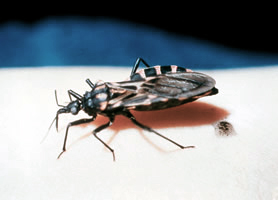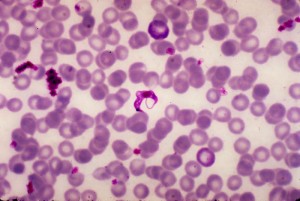Bolivia: Health officials say one million are infected with Chagas disease
April 25, 2013 - The Global Dispatch
by Robert Harriman
According to a report today by the Latin American Information Agency, the Head of the Health Ministry Chagas Program, Max Enríquez said at least one million Bolivians are infected with the parasitic infection, Chagas disease and another four million are at risk of infection.
 (left) The Triatoma or "kissing" bug. Credit: Image/CDC
(left) The Triatoma or "kissing" bug. Credit: Image/CDC
The departments being hit hardest by the parasite are Santa Cruz, Chiquisaca, Tarija, Cochabamba, Potosi and La Paz.
Enriquez notes that of all the countries in South America, Bolivia carries the biggest burden from the neglected tropical disease.
Enriquez announced that some two million USD will be allocated to prevention campaigns.
According to the World Health Organization, Chagas disease, also known as American trypanosomiasis, is a potentially life-threatening illness caused by the protozoan parasite, Trypanosoma cruzi (T. cruzi). It is found mainly in Latin America, where it is mostly transmitted to humans by the feces of triatomine bugs, known as 'kissing bugs' , among other names, depending on the geographical area.
These insects frequently carry the parasite,Trypanosoma cruzi for life. T. cruzi is a comma shaped flagellated parasite and the cause of an acute and chronic disease called Chagas.
The triatoma bug can be found in poorly constructed homes, with cracks and crevices in the walls or those with thatch roofs. They can also be found in palm trees and the fronds.
 (left) Trypanosoma cruzi in a blood smear Source: Image/CDC
(left) Trypanosoma cruzi in a blood smear Source: Image/CDC
Usually at night while sleeping, the insect feeds on people or other mammals. While feeding the insect defecates and the infected feces gets rubbed into the bite wound, eyes abrasions or other skin wounds.
The parasite invades macrophages at or near the site of entry. Here they transform, multiply and rupture from the cells 4-5 days later and enter the blood stream and tissue spaces.
Initial infection with Chagas is typically asymptomatic. Acute disease may manifest symptoms after a couple of weeks.
Reddening of the skin (Chagoma) or edema around the eye (Romana's sign ) may be seen, albeit uncommon.
Fever, malaise, enlarged liver and spleen are part of the acute syndrome. 10% of people develop acute myocaditis with congestive heart failure. This acute disease can be fatal.
After a latent period which may last for years, the infected person may develop chronic disease (20-40%). The most serious consequences are cardiomyopathy (in certain areas it's the leading cause of death in men less than 45 years of age) and megacolon/megaesophogus.
Trypanosoma cruzi can also be transmitted via congenital transmission (mother to baby), through blood transfusions and organ transplants, and some cases of transmission through feces contaminated food.
About 150 mammals beside humans may serve as reservoirs of the parasite. Dogs, cats, opossoms and rats are among the animals.